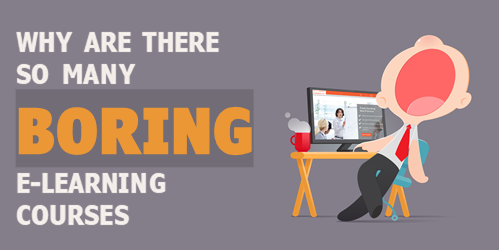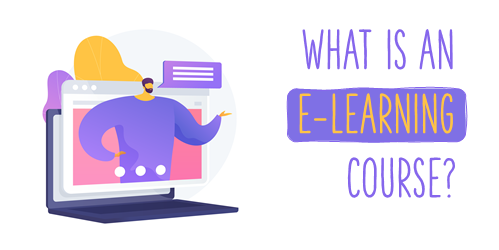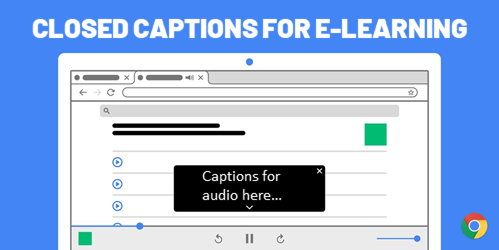 We can put together great courses, but we can't guarantee a person learns from them. Learning requires some level of interest and motivation from the person taking the course. The good news is there are things we can do to engage people and tap into their motivation. Here are a few ideas.
Add Value to Motivate Learners
Courses need to be relevant to the person. They need to know where the course fits in the scheme of things and how it impacts what they do. And people make that assessment right ...
We can put together great courses, but we can't guarantee a person learns from them. Learning requires some level of interest and motivation from the person taking the course. The good news is there are things we can do to engage people and tap into their motivation. Here are a few ideas.
Add Value to Motivate Learners
Courses need to be relevant to the person. They need to know where the course fits in the scheme of things and how it impacts what they do. And people make that assessment right ...
Read the full article
 Online training is hot right now. And between video chat services like Zoom and course authoring tools like Articulate 360, there's a lot of content creation.
Since creating the e-learning content is easy, there's often an increased demand to create yet more online training. And with that demand is the need to manage resources, which for most training organizations is limited.
Any opportunity to save time (and money) is a good thing. Here are three ideas to help manage your e-learning resources. They help improve development time and decrease the ...
Online training is hot right now. And between video chat services like Zoom and course authoring tools like Articulate 360, there's a lot of content creation.
Since creating the e-learning content is easy, there's often an increased demand to create yet more online training. And with that demand is the need to manage resources, which for most training organizations is limited.
Any opportunity to save time (and money) is a good thing. Here are three ideas to help manage your e-learning resources. They help improve development time and decrease the ...
Read the full article
 When I worked at this one place, we could only use a single PowerPoint slide for any presentation or anytime we created content in PowerPoint. There was nothing particularly special about the slide other than the fact it was the approved slide because it had the company logo and colors plastered all over it.
This became an issue when we transitioned to one of the early rapid e-learning applications. Since the courses started in PowerPoint, the branding was on every slide and took up limited screen space that we needed ...
When I worked at this one place, we could only use a single PowerPoint slide for any presentation or anytime we created content in PowerPoint. There was nothing particularly special about the slide other than the fact it was the approved slide because it had the company logo and colors plastered all over it.
This became an issue when we transitioned to one of the early rapid e-learning applications. Since the courses started in PowerPoint, the branding was on every slide and took up limited screen space that we needed ...
Read the full article
 One of the big challenges when building courses is having to deal with organization's brand and visual identity and figuring out how to work it into the course. And to do it in a way so the course doesn't look like a billboard or race car.
Here are some quick tips on how to incorporate the company's brand into your courses without being overly intrusive on the learning objectives and actual course content.
Get Rid of the Branding
Before we get started, here's a question worthy of debate: do you really need to ...
One of the big challenges when building courses is having to deal with organization's brand and visual identity and figuring out how to work it into the course. And to do it in a way so the course doesn't look like a billboard or race car.
Here are some quick tips on how to incorporate the company's brand into your courses without being overly intrusive on the learning objectives and actual course content.
Get Rid of the Branding
Before we get started, here's a question worthy of debate: do you really need to ...
Read the full article
 A lot of e-learning is compliance-based and often how it has to be delivered is a bit rigid. I've heard plenty of examples where some compliance training requires X number of seat hours to certify the completion of the training.
This is ridiculous because the seat hours are completely disconnected from whether the learner demonstrates any semblance of understanding. But, like I said, that's not going to change. And as an e-learning developer, you're stuck.
Outside of compliance training, another large chunk is what I like to call regurgitative training. That's ...
A lot of e-learning is compliance-based and often how it has to be delivered is a bit rigid. I've heard plenty of examples where some compliance training requires X number of seat hours to certify the completion of the training.
This is ridiculous because the seat hours are completely disconnected from whether the learner demonstrates any semblance of understanding. But, like I said, that's not going to change. And as an e-learning developer, you're stuck.
Outside of compliance training, another large chunk is what I like to call regurgitative training. That's ...
Read the full article
 Like many organizations, we have to take compliance training. And when I heard we had a 3-hour harassment course coming, my first emotional response wasn't positive. Why do I shudder thinking of taking a 3-hour e-learning course?
We all know why.
I hear all the time that e-learning courses are boring. This isn't 1995. What's going on?
We have conferences that teach us how to build better courses. We have an industry full of experts whose whole existence revolves around pointing out boring e-learning and selling their services to de-borify.
I write this blog hoping ...
Like many organizations, we have to take compliance training. And when I heard we had a 3-hour harassment course coming, my first emotional response wasn't positive. Why do I shudder thinking of taking a 3-hour e-learning course?
We all know why.
I hear all the time that e-learning courses are boring. This isn't 1995. What's going on?
We have conferences that teach us how to build better courses. We have an industry full of experts whose whole existence revolves around pointing out boring e-learning and selling their services to de-borify.
I write this blog hoping ...
Read the full article
 You built an e-learning course and the client is happy. Now what?
There's a lot that happens between getting the course uploaded and then delivered to those who need to consume it. And then after that, what happens next?
Here are a few ideas.
Implementation Strategy
Once a course is built, it needs to be rolled out to its intended audience. Often this part of the course construction is out of the hands of the person who builds the course. However, it's still a major consideration and many clients (especially if they're internal managers) ...
You built an e-learning course and the client is happy. Now what?
There's a lot that happens between getting the course uploaded and then delivered to those who need to consume it. And then after that, what happens next?
Here are a few ideas.
Implementation Strategy
Once a course is built, it needs to be rolled out to its intended audience. Often this part of the course construction is out of the hands of the person who builds the course. However, it's still a major consideration and many clients (especially if they're internal managers) ...
Read the full article
 "Where do I put my e-learning courses?"
The answer to this seems obvious to someone who's been building courses for a while. However, there are many people new to the industry and it's a question I get frequently.
Today, we'll do a quick survey of some common considerations when it comes to getting a course to your learners.
Does the e-learning course need to be tracked?
If so, it needs to be published for a learning management system (LMS) using one of the standard tracking options: SCORM, AICC, or xAPI.
If not, then it ...
"Where do I put my e-learning courses?"
The answer to this seems obvious to someone who's been building courses for a while. However, there are many people new to the industry and it's a question I get frequently.
Today, we'll do a quick survey of some common considerations when it comes to getting a course to your learners.
Does the e-learning course need to be tracked?
If so, it needs to be published for a learning management system (LMS) using one of the standard tracking options: SCORM, AICC, or xAPI.
If not, then it ...
Read the full article
 What do you think when someone says, "We need to build an e-learning course?"
My first thought is, "Do you really need a course?"
An "e-learning course" can mean many things and serve many purposes. Some people use the word "course," but what they really mean is "we need to make content available." What they see as a course is more like a marketing campaign. And for others a "course" is only a course if it's focused on performance.
Which gets into understanding what people want and why they want it. Then ...
What do you think when someone says, "We need to build an e-learning course?"
My first thought is, "Do you really need a course?"
An "e-learning course" can mean many things and serve many purposes. Some people use the word "course," but what they really mean is "we need to make content available." What they see as a course is more like a marketing campaign. And for others a "course" is only a course if it's focused on performance.
Which gets into understanding what people want and why they want it. Then ...
Read the full article
 A guest post by Elizabeth Pawlicki, Training Program Manager, Articulate.
If you're a Google Chrome 89+ user you now have access to Live Caption which is an accessibility feature that provides real-time captions for audio that plays through the browser.
This is a really excellent feature for audio that runs through your browser when viewing courses that have videos or narration, especially if the audio doesn't have captions. Check it out below.
Initial Thoughts on Google Live Caption
I tested the Live Captions on a few different e-learning products that ...
A guest post by Elizabeth Pawlicki, Training Program Manager, Articulate.
If you're a Google Chrome 89+ user you now have access to Live Caption which is an accessibility feature that provides real-time captions for audio that plays through the browser.
This is a really excellent feature for audio that runs through your browser when viewing courses that have videos or narration, especially if the audio doesn't have captions. Check it out below.
Initial Thoughts on Google Live Caption
I tested the Live Captions on a few different e-learning products that ...
Read the full article
 Here's a quick tip for those building e-learning courses: as a course developer you serve as the intermediary between the organization and the learner. You are the bridge between both parties.
Not All E-Learning Courses Require Learning
Before we continue, let's assume that we're not talking about compliance training which often doesn't have specific learning objectives. With compliance training, the organization commissions the course to meet some sort of compliance requirement.
However, the person who takes the course wouldn't be taking it to meet real objectives. They're only taking it to meet ...
Here's a quick tip for those building e-learning courses: as a course developer you serve as the intermediary between the organization and the learner. You are the bridge between both parties.
Not All E-Learning Courses Require Learning
Before we continue, let's assume that we're not talking about compliance training which often doesn't have specific learning objectives. With compliance training, the organization commissions the course to meet some sort of compliance requirement.
However, the person who takes the course wouldn't be taking it to meet real objectives. They're only taking it to meet ...
Read the full article
 E-learning courses are mostly screens of content made up of media: text, shapes, illustrations, pictures, and video.
Adding those things to your course is simple, usually just a matter of inserting said media onto the screen. However, building a cohesive course is more than just inserting stuff on a screen. There are other considerations.
Design the Look of the E-Learning Course
What's on a screen?
E-learning courses are mostly screens of content made up of media: text, shapes, illustrations, pictures, and video.
Adding those things to your course is simple, usually just a matter of inserting said media onto the screen. However, building a cohesive course is more than just inserting stuff on a screen. There are other considerations.
Design the Look of the E-Learning Course
What's on a screen?
...
Read the full article
 We can put together great courses, but we can't guarantee a person learns from them. Learning requires some level of interest and motivation from the person taking the course. The good news is there are things we can do to engage people and tap into their motivation. Here are a few ideas.
Add Value to Motivate Learners
Courses need to be relevant to the person. They need to know where the course fits in the scheme of things and how it impacts what they do. And people make that assessment right ...
We can put together great courses, but we can't guarantee a person learns from them. Learning requires some level of interest and motivation from the person taking the course. The good news is there are things we can do to engage people and tap into their motivation. Here are a few ideas.
Add Value to Motivate Learners
Courses need to be relevant to the person. They need to know where the course fits in the scheme of things and how it impacts what they do. And people make that assessment right ...
 Online training is hot right now. And between video chat services like Zoom and course authoring tools like
Online training is hot right now. And between video chat services like Zoom and course authoring tools like  When I worked at this one place, we could only use a single PowerPoint slide for any presentation or anytime we created content in PowerPoint. There was nothing particularly special about the slide other than the fact it was the approved slide because it had the company logo and colors plastered all over it.
This became an issue when we transitioned to one of the early rapid e-learning applications. Since the courses started in PowerPoint, the branding was on every slide and took up limited screen space that we needed ...
When I worked at this one place, we could only use a single PowerPoint slide for any presentation or anytime we created content in PowerPoint. There was nothing particularly special about the slide other than the fact it was the approved slide because it had the company logo and colors plastered all over it.
This became an issue when we transitioned to one of the early rapid e-learning applications. Since the courses started in PowerPoint, the branding was on every slide and took up limited screen space that we needed ...
 One of the big challenges when building courses is having to deal with organization's brand and visual identity and figuring out how to work it into the course. And to do it in a way so the course doesn't look like a billboard or race car.
Here are some quick tips on how to incorporate the company's brand into your courses without being overly intrusive on the learning objectives and actual course content.
Get Rid of the Branding
Before we get started, here's a question worthy of debate: do you really need to ...
One of the big challenges when building courses is having to deal with organization's brand and visual identity and figuring out how to work it into the course. And to do it in a way so the course doesn't look like a billboard or race car.
Here are some quick tips on how to incorporate the company's brand into your courses without being overly intrusive on the learning objectives and actual course content.
Get Rid of the Branding
Before we get started, here's a question worthy of debate: do you really need to ...
 A lot of e-learning is compliance-based and often how it has to be delivered is a bit rigid. I've heard plenty of examples where some compliance training requires X number of seat hours to certify the completion of the training.
This is ridiculous because the seat hours are completely disconnected from whether the learner demonstrates any semblance of understanding. But, like I said, that's not going to change. And as an e-learning developer, you're stuck.
Outside of compliance training, another large chunk is what I like to call regurgitative training. That's ...
A lot of e-learning is compliance-based and often how it has to be delivered is a bit rigid. I've heard plenty of examples where some compliance training requires X number of seat hours to certify the completion of the training.
This is ridiculous because the seat hours are completely disconnected from whether the learner demonstrates any semblance of understanding. But, like I said, that's not going to change. And as an e-learning developer, you're stuck.
Outside of compliance training, another large chunk is what I like to call regurgitative training. That's ...
 Like many organizations, we have to take compliance training. And when I heard we had a 3-hour harassment course coming, my first emotional response wasn't positive. Why do I shudder thinking of taking a 3-hour e-learning course?
We all know why.
I hear all the time that e-learning courses are boring. This isn't 1995. What's going on?
We have conferences that teach us how to build better courses. We have an industry full of experts whose whole existence revolves around pointing out boring e-learning and selling their services to de-borify.
I write this blog hoping ...
Like many organizations, we have to take compliance training. And when I heard we had a 3-hour harassment course coming, my first emotional response wasn't positive. Why do I shudder thinking of taking a 3-hour e-learning course?
We all know why.
I hear all the time that e-learning courses are boring. This isn't 1995. What's going on?
We have conferences that teach us how to build better courses. We have an industry full of experts whose whole existence revolves around pointing out boring e-learning and selling their services to de-borify.
I write this blog hoping ...
 You built an e-learning course and the client is happy. Now what?
There's a lot that happens between getting the course uploaded and then delivered to those who need to consume it. And then after that, what happens next?
Here are a few ideas.
Implementation Strategy
Once a course is built, it needs to be rolled out to its intended audience. Often this part of the course construction is out of the hands of the person who builds the course. However, it's still a major consideration and many clients (especially if they're internal managers) ...
You built an e-learning course and the client is happy. Now what?
There's a lot that happens between getting the course uploaded and then delivered to those who need to consume it. And then after that, what happens next?
Here are a few ideas.
Implementation Strategy
Once a course is built, it needs to be rolled out to its intended audience. Often this part of the course construction is out of the hands of the person who builds the course. However, it's still a major consideration and many clients (especially if they're internal managers) ...
 "Where do I put my e-learning courses?"
The answer to this seems obvious to someone who's been building courses for a while. However, there are many people new to the industry and it's a question I get frequently.
Today, we'll do a quick survey of some common considerations when it comes to getting a course to your learners.
Does the e-learning course need to be tracked?
If so, it needs to be published for a learning management system (LMS) using one of the standard tracking options: SCORM, AICC, or xAPI.
If not, then it ...
"Where do I put my e-learning courses?"
The answer to this seems obvious to someone who's been building courses for a while. However, there are many people new to the industry and it's a question I get frequently.
Today, we'll do a quick survey of some common considerations when it comes to getting a course to your learners.
Does the e-learning course need to be tracked?
If so, it needs to be published for a learning management system (LMS) using one of the standard tracking options: SCORM, AICC, or xAPI.
If not, then it ...
 What do you think when someone says, "We need to build an e-learning course?"
My first thought is, "Do you really need a course?"
An "e-learning course" can mean many things and serve many purposes. Some people use the word "course," but what they really mean is "we need to make content available." What they see as a course is more like a marketing campaign. And for others a "course" is only a course if it's focused on performance.
Which gets into understanding what people want and why they want it. Then ...
What do you think when someone says, "We need to build an e-learning course?"
My first thought is, "Do you really need a course?"
An "e-learning course" can mean many things and serve many purposes. Some people use the word "course," but what they really mean is "we need to make content available." What they see as a course is more like a marketing campaign. And for others a "course" is only a course if it's focused on performance.
Which gets into understanding what people want and why they want it. Then ...
 A guest post by Elizabeth Pawlicki, Training Program Manager, Articulate.
If you're a Google Chrome 89+ user you now have access to
A guest post by Elizabeth Pawlicki, Training Program Manager, Articulate.
If you're a Google Chrome 89+ user you now have access to  Here's a quick tip for those building e-learning courses: as a course developer you serve as the intermediary between the organization and the learner. You are the bridge between both parties.
Not All E-Learning Courses Require Learning
Before we continue, let's assume that we're not talking about compliance training which often doesn't have specific learning objectives. With compliance training, the organization commissions the course to meet some sort of compliance requirement.
However, the person who takes the course wouldn't be taking it to meet real objectives. They're only taking it to meet ...
Here's a quick tip for those building e-learning courses: as a course developer you serve as the intermediary between the organization and the learner. You are the bridge between both parties.
Not All E-Learning Courses Require Learning
Before we continue, let's assume that we're not talking about compliance training which often doesn't have specific learning objectives. With compliance training, the organization commissions the course to meet some sort of compliance requirement.
However, the person who takes the course wouldn't be taking it to meet real objectives. They're only taking it to meet ...
 E-learning courses are mostly screens of content made up of media: text, shapes, illustrations, pictures, and video.
Adding those things to your course is simple, usually just a matter of inserting said media onto the screen. However, building a cohesive course is more than just inserting stuff on a screen. There are other considerations.
Design the Look of the E-Learning Course
What's on a screen?
E-learning courses are mostly screens of content made up of media: text, shapes, illustrations, pictures, and video.
Adding those things to your course is simple, usually just a matter of inserting said media onto the screen. However, building a cohesive course is more than just inserting stuff on a screen. There are other considerations.
Design the Look of the E-Learning Course
What's on a screen?



0
comments